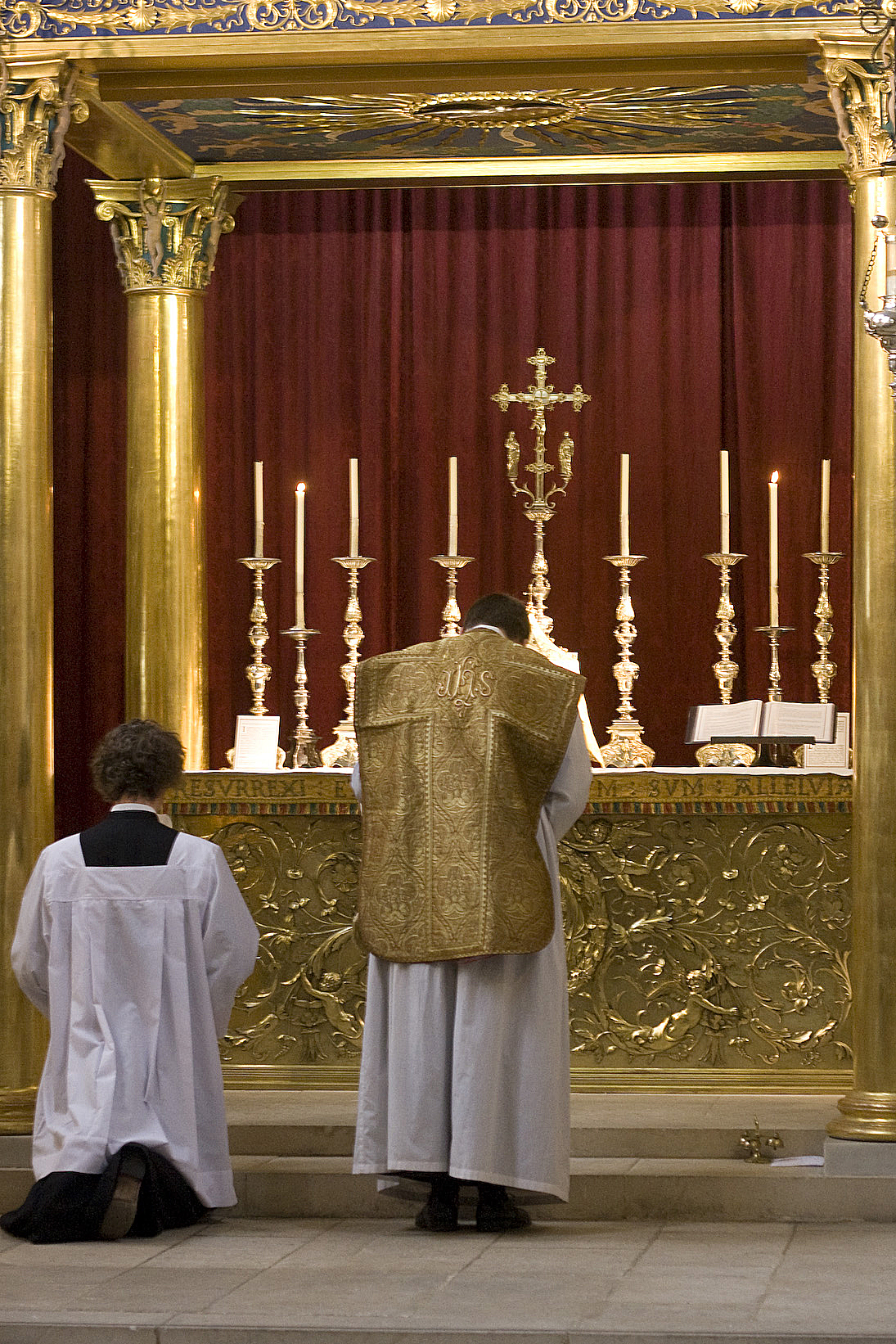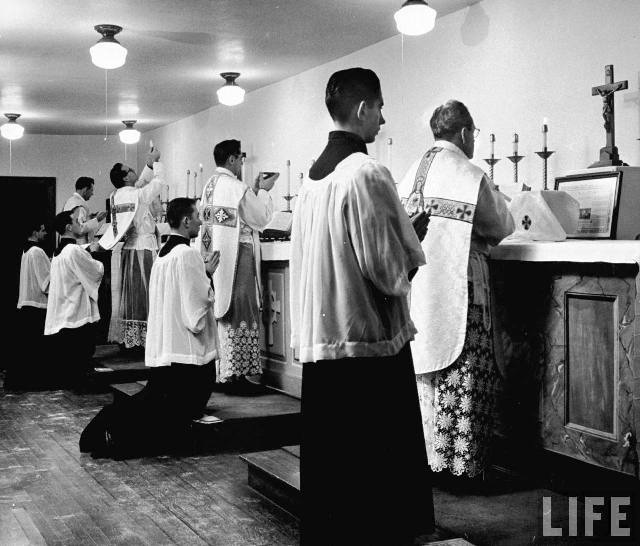

In Defense of Individual Celebration of the Holy Mass
Tridentine Community News (July 26, 2009):
The 1983 Code of Canon Law urges priests to celebrate the Holy Sacrifice of the Mass every day. Canon 276 §2 n. 2 states: “... priests are earnestly invited to offer the eucharistic sacrifice daily ...”. (Key point: It is not mandatory.)
Priests living in a religious community, such as at a monastery, often have a regularly scheduled daily Mass. If they follow the Ordinary Form, this Community Mass can be one in which some or all of the priests concelebrate the Mass.
If the religious community, or an individual priest, follows the Extraordinary Form, concelebration is not permitted. Each priest must celebrate his own individual Mass. The below historic photo shows priests celebrating private Masses at Orchard Lake’s Ss. Cyril & Methodius Seminary, pre-Vatican II.
The above photo and the below historic one from St. Charles Senior Living Community, the former seminary of the Missionaries of the Precious Blood in Ohio, show an orderly, detailed atmosphere.
Detroit’s Sacred Heart Seminary has similar side altars lining the walls of its chapel. Older churches such as our own were constructed with side altars for the same reason, to allow the assisting priests in residence at the parish to offer their own Masses each day. In an interesting sign of the times, at the Fraternity of St. Peter’s seminary in Nebraska, priests celebrate their individual Masses in a room cluttered with mismatched side altars salvaged from various churches.
A little-known fact is that there is one time that a priest may concelebrate at a Tridentine Mass, and that is at a Mass of Ordination. Each ordinand concelebrates the Mass with the bishop. Each new priest is assisted by an experienced priest at his side, as pictured in this photo from an Institute of Christ the King ordination.
Practical Considerations
On the surface, concelebration seems to be a sensible solution in a world of too few priests having too many responsibilities. Why force every priest to take the time for his own Mass, especially in an assembly line-like atmosphere? The principal opposing argument maintains that additional graces flow from multiple individual Masses that do not comparably flow from one concelebrated Mass. We will leave it to theologians to debate this point, but we do note that more Masses allow for more Mass Intentions to be offered.
More concretely, when priests celebrate individual Masses, they can better concentrate on the Holy Sacrifice and the day’s Mass Intention. Human nature tells us that the reduced involvement of concelebrants opens up a greater possibility of mental distractions on their part. This is less likely to be the case with individual celebration, especially if each priest knows that he is under the watchful eye of a server. It is ironic that the option of concelebration arguably de-emphasizes “active participation” for priests, just as it is emphasized for the laity. Therefore, just as concelebration may offer a practical benefit in today’s world, so does individual celebration: That of improved focus on the Mass.
We also suggest that it is spiritually beneficial for priests to be in the habit of celebrating the entire Holy Mass. Just as it can be all too easy for laypeople to get out of the habit of praying a daily Rosary, we suspect that there is a slippery slope aspect to priests relying too often on concelebration. The discipline of the Extraordinary Form requiring priests following it to celebrate their own Masses provides a spiritual safety belt: A priest cannot help but grow in holiness as he develops a more intimate knowledge of the liturgical year and its Propers, and by having the opportunity to offer more Mass Intentions at those additional Holy Sacrifices.
[Comments? Please e-mail tridnews@stjosaphatchurch.org. Previous columns are available at www.stjosaphatchurch.org. This edition of Tridentine Community News, with minor editions, is from the St. Josaphat bulletin insert for July 26, 2009. Hat tip to A.B.]

 inundado por um mistério de luz que é Deus e N´Ele vi e ouvi -A ponta da lança como chama que se desprende, toca o eixo da terra, – Ela estremece: montanhas, cidades, vilas e aldeias com os seus moradores são sepultados. - O mar, os rios e as nuvens saem dos seus limites, transbordam, inundam e arrastam consigo num redemoinho, moradias e gente em número que não se pode contar , é a purificação do mundo pelo pecado em que se mergulha. - O ódio, a ambição provocam a guerra destruidora! - Depois senti no palpitar acelerado do coração e no meu espírito o eco duma voz suave que dizia: – No tempo, uma só Fé, um só Batismo, uma só Igreja, Santa, Católica, Apostólica: - Na eternidade, o Céu!
inundado por um mistério de luz que é Deus e N´Ele vi e ouvi -A ponta da lança como chama que se desprende, toca o eixo da terra, – Ela estremece: montanhas, cidades, vilas e aldeias com os seus moradores são sepultados. - O mar, os rios e as nuvens saem dos seus limites, transbordam, inundam e arrastam consigo num redemoinho, moradias e gente em número que não se pode contar , é a purificação do mundo pelo pecado em que se mergulha. - O ódio, a ambição provocam a guerra destruidora! - Depois senti no palpitar acelerado do coração e no meu espírito o eco duma voz suave que dizia: – No tempo, uma só Fé, um só Batismo, uma só Igreja, Santa, Católica, Apostólica: - Na eternidade, o Céu! 